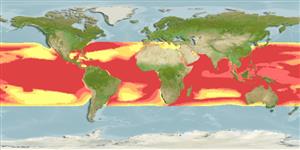Preferred temperature (Ref.
115969): 21.3 - 28.9, mean 27.2 (based on 4410 cells).
Phylogenetic diversity index (Ref.
82804): PD
50 = 0.5029 [Uniqueness, from 0.5 = low to 2.0 = high].
Bayesian length-weight: a=0.00229 (0.00133 - 0.00396), b=3.10 (2.94 - 3.26), in cm Total Length, based on LWR estimates for this species & (Sub)family-body (Ref.
93245).
Τροφικό Επίπεδο (Ref.
69278): 4.3 ±0.5 se; based on diet studies.
Ελαστικότητα (Ref.
120179): Χαμηλό, ελάχιστος χρόνος για διπλασιασμό πληθυσμού 4,5 - 14 έτη (tmax=30; tm=8.2; Fec=13).
Fishing Vulnerability (Ref.
59153): Very high vulnerability (90 of 100).
